 It’s hard to know where to begin telling you about our in-many-ways-wonderful-but-in-others-dreadful weekend trip to Wales. Let’s see…how about from the drenching downpour that dumped seemingly endless buckets of water on our boat to Skomer Island on Saturday morning? Or from the climb up the steep island cliff, a climb made even more taxing by the blinding sheets of rain and the heavy water-sogged jeans clinging to our legs and dripping water inside our by-then-useless gore-tex boots?
It’s hard to know where to begin telling you about our in-many-ways-wonderful-but-in-others-dreadful weekend trip to Wales. Let’s see…how about from the drenching downpour that dumped seemingly endless buckets of water on our boat to Skomer Island on Saturday morning? Or from the climb up the steep island cliff, a climb made even more taxing by the blinding sheets of rain and the heavy water-sogged jeans clinging to our legs and dripping water inside our by-then-useless gore-tex boots?
Hmmm, let’s begin with early Saturday morning in Martin’s Haven…where we waited in line for the Skomer boat to pick us up. It was a very short line…the huge crowds that I had read about and expected were nowhere to be seen…I counted no more than a dozen cheerful and friendly Brits. We later understood that most day trippers had been discouraged, rightly so!, by the dismal weather reports. Looking around, I 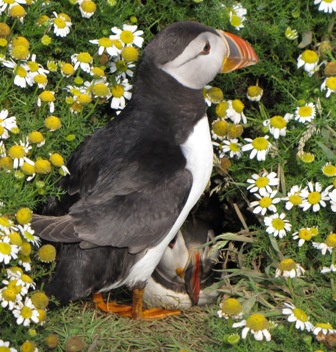 noticed that everyone else, even those staying just for one night (like us), had huge clunky bags compared to our small light knapsacks…how odd, I thought…
noticed that everyone else, even those staying just for one night (like us), had huge clunky bags compared to our small light knapsacks…how odd, I thought…
It was only when the above-described deluge began that I realized how dumb we had been. Our fellow travelers had at least two or three changes of WARM easy-to-dry clothes, whereas we had only one miserable little change of clothes (=heavy cotton, which takes forever to dry), and, duuuh, no extra shoes except flip flops…During the crossing, almost everything–our towels, extra socks, underwear/knickers and pyjamas–got soaked…everything except our sleeping bags, which I had had the unusual foresight to stuff inside a big plastic bag.
As if being wet wasn’t bad enough, on Saturday evening the temperature on the island dropped to the point where Stefano and I also got a bit chilled….so while the others went off in their warm dry clothes to watch the Manx Sheerwaters fly about at midnight, we had to give up by 10:30 PM and go to bed, shivering and cursing our stupidity…but I would lik e to note that, in spite of my weakened immune system, I didn’t get even the slightest of sniffles. I was and am fine. Just fine. Thanks to curcumin? Probably. My poor Stefano instead developed a cough and is currently on antibiotics (he is not a regular curcumin-taker…).
e to note that, in spite of my weakened immune system, I didn’t get even the slightest of sniffles. I was and am fine. Just fine. Thanks to curcumin? Probably. My poor Stefano instead developed a cough and is currently on antibiotics (he is not a regular curcumin-taker…).
Well, we soon found out that the weather can change rapidly on Skomer. In a matter of minutes, terrific offshore winds could blow in terrific offshore rainstorms, which usually lasted long enough for us to get soaked to the bone…again. No matter…this taught us a few useful lessons for our next trip to Skomer:
1. come better equipped, with waterproof pants and warmer clothes, even in July.
2. keep an eye on the more weather-savvy Brits. Whenever they stop snapping photographs and speed off toward the island farmhouse, make haste to follow them. At one point, you see, Stefano and I were so busy taking photos of adorable puffins that we didn’t notice that everyone else had disappeared…then, all of a sudden, whoosh splat splat!!!, our still-damp pants got thoroughly soaked again.
3. don’t lose sight of the horizon. At the first sign of a dark cloud, sprint for shelter.
Luckily, it didn’t rain all the time. The sun came out here and there. As soon as it did, we would rush downstairs to put on our waterlogged socks and boots and head toward the Wick, where the main island puffin population lives. We didn’t see any chicks but heard that a woman photographer got a photo of a puffling (baby puffin) being fed by a parent. Drat.
 Ah, that reminds me of an amusing occurrence. Whenever we ran into other photographers, a couple of whom, judging by their expensive equipment and demeanour, were certainly professionals, we would exchange pleasantries, such as “hello…sooo, what did you get?” I would answer, elatedly “I got a shot of a puffin carrying some fish in its beak! How about you?” Invariably, the response would be something like “oh, that’s lovely…hum, well, I got a shot of a puffin standing on its head and sipping a frozen margarita through a straw while reading a local newspaper and smoking a cigar…” Yep, I was always put to shame. After a couple of times, I stopped asking…
Ah, that reminds me of an amusing occurrence. Whenever we ran into other photographers, a couple of whom, judging by their expensive equipment and demeanour, were certainly professionals, we would exchange pleasantries, such as “hello…sooo, what did you get?” I would answer, elatedly “I got a shot of a puffin carrying some fish in its beak! How about you?” Invariably, the response would be something like “oh, that’s lovely…hum, well, I got a shot of a puffin standing on its head and sipping a frozen margarita through a straw while reading a local newspaper and smoking a cigar…” Yep, I was always put to shame. After a couple of times, I stopped asking…
Aside from the amazingly unpredictable weather, my most vivid memory of Skomer is of puffins at our feet…yes indeedie, they came so close that we could have reached down to pat their cute little heads (we didn’t, of course!, but the temptation was enormous…).
Puffins at our feet, tilting their heads to look up at us (=two tall peculiar featherless and wingless creatures), inquisitively and with no trace of fear or distrust. Quite a different experience compared to the one we had on the Farne Islands last year…undoubtedly because, even with the day trippers, there was only a handful of people on Skomer (again, probably due to the poor weather conditions).
And, once the few hardy day trippers had left on the 2:30 PM boat, on a couple of occasions Stefano and I found ourselves alone at the Wick…just the two of us, surrounded by puffins strutting about,  diving off the cliffs, landing clumsily on land with their beaks filled with sand eels, whizzing past us like flying bullets, tenderly “kissing” their partners, tugging away at weeds, picking up small stones with their beaks…and delighting us beyond measure…
diving off the cliffs, landing clumsily on land with their beaks filled with sand eels, whizzing past us like flying bullets, tenderly “kissing” their partners, tugging away at weeds, picking up small stones with their beaks…and delighting us beyond measure…
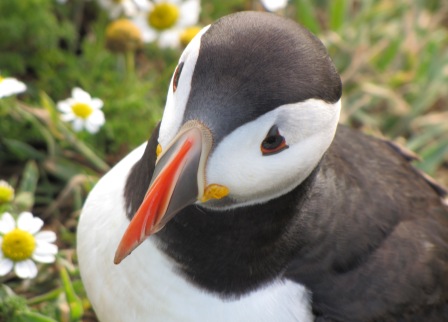
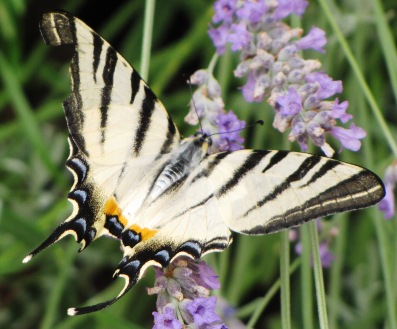 and there was the most extraordinary butterfly I have ever seen, certainly in Italy. I dashed inside to grab my camera and spent the next 15-20 minutes (or more) alternately taking photographs and standing still to admire this gorgeous insect.
and there was the most extraordinary butterfly I have ever seen, certainly in Italy. I dashed inside to grab my camera and spent the next 15-20 minutes (or more) alternately taking photographs and standing still to admire this gorgeous insect. 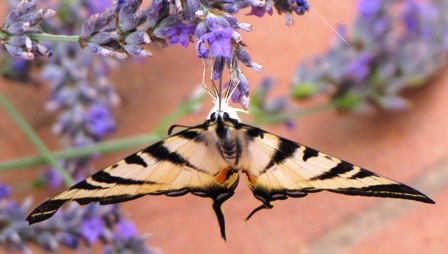 known as the paw paw butterfly, since the caterpillar likes to feed on young and tender paw paw plants (coincidentally, paw paw is used as an alternative cancer treatment, see
known as the paw paw butterfly, since the caterpillar likes to feed on young and tender paw paw plants (coincidentally, paw paw is used as an alternative cancer treatment, see 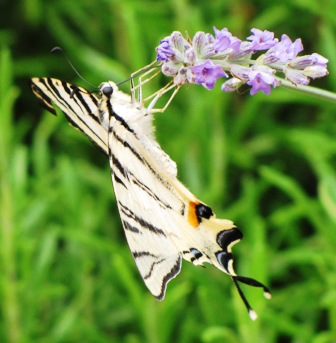 My friend had a slight injury to her left wing but otherwise seemed fine. She certainly drank an enormous amount of nectar from my lavender blooms, using her proboscis, or long flexible tongue (see photos). After taking about a million photographs, I went to call Stefano and my parents. Stefano arrived with his super duper camera and took several photos, too. When it began raining, though, we had to go back into the house.
My friend had a slight injury to her left wing but otherwise seemed fine. She certainly drank an enormous amount of nectar from my lavender blooms, using her proboscis, or long flexible tongue (see photos). After taking about a million photographs, I went to call Stefano and my parents. Stefano arrived with his super duper camera and took several photos, too. When it began raining, though, we had to go back into the house.